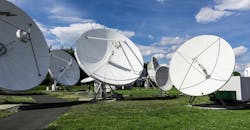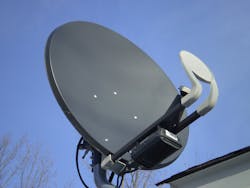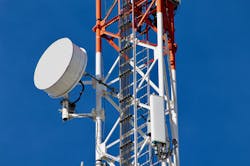Download this article in PDF format.
Wireless technology has become an essential part of modern lives, almost as much as electricity. High-frequency wireless signals are applied in many different forms, typically for communications. Signals may travel as far as from the Earth to an orbiting satellite, and back again, to as nearby as inches from a wireless transceiver in an office building.
Such communications systems operate by means of long- and short-haul links, requiring such critical components as antennas, receivers, and transmitters. But, while the block diagrams for these links may appear quite similar, the performance requirements for wireless communications links can be quite different, as typified by the many different standards that capture the operating parameters specific to each type of communications system.
For a wireless communications link, the maximum possible distance while maintaining normal radio operation will be determined by a number of factors, including transmit power, receive sensitivity, signal frequency/wavelength, and interference from other radio waves and the surrounding environment. Radio links are usually considered under ideal conditions, which is the line-of-sight (LOS) distance between the transmitter and the receiver. As a condition of electromagnetic (EM) propagation, the radio waves will suffer some amount of path loss even with optimum LOS operating conditions and no obstructions. Path loss refers to the decrease in strength of radio waves over distance.
Transmit power is one of the main factors in achieving an RF/microwave link of any considerable distance. This is due to the fact that radio waves follow an inverse square law in terms of distance traveled. When the distance of a radio link is doubled, there will be one-fourth the amount of transmitted power at the receiver.
From the point of view of the transmitter, if the transmit power for an RF/microwave link is quadrupled, or raised by 6 dB from a starting point, it will double the distance that can be covered by that radio link, assuming the same sensitivity at the receiver for both transmitter power levels. Wireless communications systems designers typically use a link budget to account for the various gains and losses in a link to estimate the amount of signal power that’s expected to be available at the receiver.
The Long and the Short of It
Although there’s no absolute definition as to what constitutes a short-haul wireless link versus a long-haul link, a short-haul link is considered anything covering a few kilometers or less while a long-haul link is usually 20 to 50 km or longer. The relatively long wireless links between cellular communications systems, such as 4G LTE, can usually be identified, at least at one end, by their fairly large parabolic dish antennas (Fig. 1).
1. Long-haul microwave links can be identified by their use of large, parabolic dish antennas at each end of the link.
Frequency plays a part in any link budget, especially for longer links, since long-distance links require the longer propagation distances of larger-wavelength, lower-frequency signals rather than smaller-wavelength, higher-frequency signals. Long-distance microwave radio links are usually operating at lower frequencies licensed by an applicable government organization, such as the Federal Communications Commission (FCC). Licensed bands at 6 and 11 GHz are now used for long-haul links in 4G LTE systems, to transfer callers from their local access point to their intended listener.
With the growing number of users for 4G LTE wireless services, the available bandwidth of these licensed link frequencies is quickly being saturated. Today’s wireless users seek more than voice service, using their smartphone or other mobile device for internet access, e-mail, high-speed data transfers, and video streaming.
The rapid consumption of network and link capacity in 4G LTE has spurred the design and development of the next or fifth-generation (5G) wireless network with its totally different radio link structure. Rather than linking large cells or base stations over relatively long distances (Fig. 2), a 5G network will use higher-frequency backhaul links over shorter distances, relying on a much greater number of smaller, closely spaced cell sites to create a wireless network. The shorter links will be made at licensed and unlicensed millimeter-wave frequencies with their abundance of available bandwidth to serve the growing number of users.
The smaller cells and higher frequencies of 5G radio links will employ smaller antennas than 4G LTE systems. In either network approach, installing a long-haul link with optimum performance requires precise alignment of the antennas at both ends of the link.
2. Current 4G LTE cellular communications networks rely on larger antennas and base stations than those that will be used in 5G systems.
In 4G LTE systems, with their larger antennas, antennas are aligned with the aid of both software and hardware. Simulation software can be used to perform a site survey at each end of the link, to model the effects of signal-absorbing objects like foliage as well as signal reflections from nearby metal surfaces. The LOS bearing of the antenna at each end of the link must be approximated and then the appropriate test equipment, such as a microwave signal generator and spectrum analyzer, used to generate in-band signals and measure the signal strength for both link directions. Shifting the position of either antenna will impact the received signal strength.
When greater distance is needed between antennas in a long-haul link, say, because of available sites for LOS antenna placement, a number of options are available for extending the operational distance of a long-haul microwave link. For example, the gain of one or both of the antennas in the link can be increased to boost the signal strength. As a complement, the loss of associated components in the link, such as interconnecting coaxial cables, couplers, and filters, can be minimized through careful specification of these components.
Further distance, as noted earlier, can also be achieved by increasing the transmit power on both sides of the link. Similarly, receivers with enhanced receive sensitivity can extend the effective link distance. Of course, all of these options result in higher equipment costs, which may be unavoidable due to available site locations.
5G’s Shorter Radio Links
Although 5G will employ somewhat shorter radio links than 4G LTE systems, with smaller antennas as a function of shorter wavelengths, the antenna alignment procedure may be made somewhat more complicated by the use of mmWave signals. While smaller antennas can be easier to align over shorter distances than larger antennas over longer distances, the required gain of the antennas will play a role in the alignment difficulty, with high gain making alignment more difficult. 5G’s radio links will enhance antenna performance through the use of multiple smaller antennas, for focused beamforming use and in multiple-input, multiple-output (MIMO) architectures.
Many wireless users are quite familiar with short-haul wireless links from their daily use of wireless local-area networks (WLANs) and the many short-range wireless standards for connecting devices like mobile phones, computers, and even a growing number of Internet of Things (IoT) sensors. The IEEE has developed many standards for WLAN equipment and networks as variations on the initial IEEE 802.11 WLAN standard at 2.4 GHz and 2 Mb/s, including popular Wi-Fi short-haul applications.
Other versions of IEEE 802.11 include IEEE 802.11a, which uses more available bandwidth at 5 GHz to achieve data rates to 54 Mb/s; IEEE 802.11ac, which combines three data streams each at 433 Mb/s to provide data rates to 1.3 Gb/s; and even a 60-GHz standard, IEEE 802.11ad, which is capable of data rates to 7 Gb/s. While these standards detail frequencies, bandwidths, modulation types, and other operating parameters, they don’t specify link distance.
Most users associate wireless standards for WLAN as being short-haul wireless applications. However, they’re not limited to any specific range, and can be extended in operating distance by means of the same practices applied to long-haul links or by adding repeaters that relay signals over longer distances.
Longer-range versions of Wi-Fi equipment have been developed in recent years to create longer unlicensed radio links than possible with conventional Wi-Fi equipment. These long range Wi-Fi networks, which operate within the established, unlicensed 2.4-GHz ISM band for Wi-Fi, offer options to cellular networks and even satellite links for longer-distance point-to-point communications. Still, the link budget requirements apply, and the radio link can only go as far as its frequencies, antennas, receivers, and transmitters will allow.
About the Author
Jack Browne
Technical Contributor
Jack Browne, Technical Contributor, has worked in technical publishing for over 30 years. He managed the content and production of three technical journals while at the American Institute of Physics, including Medical Physics and the Journal of Vacuum Science & Technology. He has been a Publisher and Editor for Penton Media, started the firm’s Wireless Symposium & Exhibition trade show in 1993, and currently serves as Technical Contributor for that company's Microwaves & RF magazine. Browne, who holds a BS in Mathematics from City College of New York and BA degrees in English and Philosophy from Fordham University, is a member of the IEEE.



